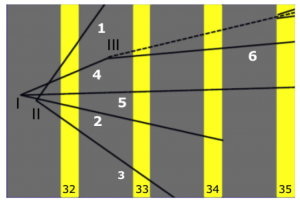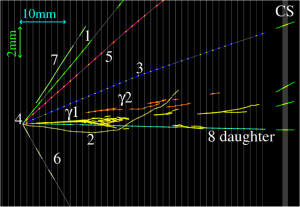
In a paper recently published on the prestigious Physical Review Letters, the OPERA collaboration reported the appearance of ten tau neutrinos in a beam of muon neutrinos, inserting the missing tile in the puzzle of neutrino oscillation.
Neutrinos are particles extremely difficult to detect, since they have no electric charge and low probability of interaction with matter. They manifest themselves in three different “flavours”: electron, muon and tau neutrinos, corresponding to the three charged leptons produced in the neutrino interaction with matter. As a consequence of quantum mechanics we also know that neutrinos can switch from one flavour to another (oscillation) along their path.
The OPERA experiment used the neutrino beam produced at CERN and called CNGS (CERN Neutrinos to Gran Sasso). Thanks to the very low probability of interaction, after an undisturbed path of 732 km through the Earth’s crust, the neutrinos of the beam reached the experimental apparatus, located in the underground laboratories of Gran Sasso, designed to observe their transformation in tau neutrinos. In order to identify beyond every reasonable doubt the taus produced in neutrino interactions, the experiment exploited the nuclear emulsion technique, which, in 1947, allowed, for the first time, the observation of the pion while studying cosmic rays in the Earth’s atmosphere.
Nuclear emulsions are similar to the now obsolete photographic plates: they are exposed to charged particles; the latter leave traces observable with optical microscopes after some chemical processing named “development”. In the OPERA experiment emulsion plates were interleaved with lead sheets, 1 mm thick, inside “bricks” of (12 x 10 x 7) cm3 volume. Indeed, the tau decays into a space of 1 mm and in this way it is possible to reconcile the precision of space measurements (of one thousandth of a millimeter) with the need to obtain many interactions (thanks to the high atomic weight of lead). Figures 1 and 2 show the first tau candidate observed by OPERA; the second one allows us also to appreciate the precision achievable through nuclear emulsions.

The experiment had also some detectors which provided real time accurate information about neutrino interactions, selecting the bricks to be analyzed and measuring with precision the charge and momentum of the muons produced in the interactions of those neutrinos that did not oscillate. The overall mass of the Lead – which is that useful to reconstruct the tau neutrino interactions in the emulsions – was of 1250 tons, but the whole experiment weighted more than 3500 tons. The apparatus also included robotic machines for the construction of the bricks and their extraction during the data taking.
It is worth mentioning here the fundamental contribution to the experiment by the physicists, engineers and technicians of the Frascati Laboratories, in the phases of design, implementation and running of the experiment, which has been collecting data from 2008 to 2012 and was subsequently dismantled.
The data analysis, slowed down by the emulsion development and the scan operations (which were carried out with dozens of microscopes between Europe and Japan), ended in 2016, with about 7000 events reconstructed. For what concerns the measure published in the recent article, the use of modern analytical techniques, such as the “Boosted Decision Tree”, was fundamental. One of the 10 events published, showed in Figure 1, is the first – and at present the only one ever observed – interaction of a tau neutrino with production of a tau together with a particle containing the c-quark. The amount of taus observed allowed the measure of the tau neutrino interaction cross section, though with a 30% precision. Actually, it should be noticed that only another experiment collected a similar sample of tau neutrinos, using emulsions as well: it is DONUT at Fermilab. However, the sample measured by DONUT was contaminated with antineutrinos, which have a cross section different from the one of neutrinos.
Thanks to the use of emulsions, OPERA is the only experiment capable to observe all three types of neutrino, distinguishing the lepton produced in the interactions: the tau as an unstable particle decaying into a space of 1 mm, the muon as an extremely penetrating particle, and the electron as a particle producing a shower of other particles. In the coming months the collaboration is going to publish the results on the oscillation of muon neutrinos into electron neutrinos, as well as the measurement of the disappearance of muon neutrinos..
The results will be analyzed also in relation with possible physics beyond the Standard Model of elementary particles, considering the existence of other types of neutrinos, the so-called sterile neutrinos, the changes of neutrino flavour induced by not standard interactions with matter while travelling from CERN to Gran Sasso, or invariance violation for Lorentz transformations (one of the bases of Einstein’s Theory of Relativity). It is worth noticing that the relatively high energy of the neutrinos of the CNGS beam (a few dozen of GeV) makes these measurements complementary to those already published by other experiments (MINOS, T2K, NOvA) using beams at lower energy.
The OPERA experiment also performed interesting studies on cosmic rays. Indeed, underground detectors can measure the muons produced from the interaction of cosmic rays in the atmosphere at high altitude, allowing the study of a wide range of scientific phenomena, from high energy particle interactions to atmospheric physics.
The events reconstructed inside OPERA (the ten tau neutrinos produced by oscillations and the interactions of the muon neutrinos which instead did not undergo any change) are already available for educational purposes on the CERN website, together with those of the LHC experiments.
While digital photography replaced the old rolls in everyday life, the nuclear emulsion technique will continue to be used in particle physics, also thanks to advancements in scan operations, which reached a speed of 190 cm2/h, 10 times greater than the one of the OPERA microscopes, which, at the time, was considered a record. Indeed there are some proposals of experiments based on nuclear emulsions. Among them, it is worth remembering NEWS at Gran Sasso (for the directional detection of dark matter by using polarized light in the microscopes) and SHiP at CERN (aiming, among other things, at collecting a sample of about 1000 tau neutrinos to better study their characteristics and to measure their cross section with precision).
As a curiosity, in the figure below you can see a particular image of the experiment, which was taken using an emulsion sheet as photographic plate. (Alessandro Paoloni)

Translation by Camilla Paola Maglione, Communications Office INFN-LNF
 INFN-LNF Laboratori Nazionali di Frascati
INFN-LNF Laboratori Nazionali di Frascati